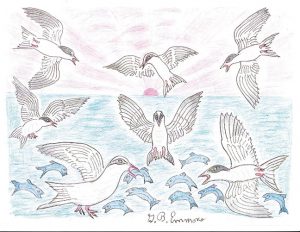The common tern in autumn migrates past our shores of Buzzards Bay in large numbers.
It spends most of its life out in the ocean, skimming the surface of the water with an orange elongated bill that scoops up insects and crustaceans.
Terns gather in a spectacle, swarming over schools of baitfish driven to the surface by ravenous blue fish or stripers, as in my illustration. In the cacophony of excitement, they utter a loud two-syllable ‘kee-yah’ alarm call, which also tells nearby fishermen to know where to cast a line.
The common tern is one of three species of terns here that are now passing us heading south toward Cape Ann in New Jersey, and from there many fly directly to the West Indies. They will return in spring to breed and nest inland on rocky coasts of islands on the way to their northern range beyond the U.S.A. into Canada.
The other two species are the slightly larger Forster’s tern and the slightly smaller arctic tern, which makes up for its size with a vastly extended and astounding migration distance of some 25,000 miles. It travels from the high Arctic all the way to the Antarctic in a figure eight pattern, longer than any other bird. It crosses every ocean and touches each corner of North America. All species of terns stop along their migration route almost midway in spring to nest in groups called colonies.
As love arrives with them in the temporal air of the season, it brings spectacular aerial high flight courtship dances. Then, as with many other birds, there follows a final ground ceremony performed as each pair postures, bows, struts in circles, and the male often presents a fish to the female.
Since the Migratory Bird Act of 1913, the numbers of terns have increased dramatically. They are also uncommonly immune from earthly exposure to environmental pollution hazards, except of course to pesticides, causing two or three laid eggs not to hatch.
The seaward passing of terns along the Atlantic Ocean, across the Equator, and down to the semi-darkness of the South Pole, is a tale of the success of migration and reproduction accentuated by the spring and autumn equinoxes. For you and me as bird watchers, thanks again for joining me in this phenomenon of environmental awareness.
By George B. Emmons
